
RFA Fort Rosalie was the lead ship of her class of Royal Fleet Auxiliary fleet replenishment ships. Fort Rosalie was originally named RFA Fort Grange, but was renamed in May 2000 to avoid confusion with the now-decommissioned RFA Fort George. On 31 March 2021, the ship was withdrawn from service.

The Durance class is a series of multi-product replenishment oilers, originally designed and built for service in the French Navy. Besides the five ships built for the French Navy, a sixth was built for the Royal Australian Navy, while the lead ship of the class currently serves with the Argentine Navy. Two ships of a similar but smaller design are in service with the Royal Saudi Navy as the Boraida-class replenishment oilers.
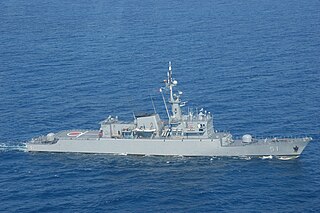
The Almirante Padilla-class frigates is a series of frigates operated by the Colombian Navy. The designation of this class is Type FS 1500 and there are four ships in service. The ships were built by Howaldtswerke-Deutsche Werft (HDW) at Kiel, West Germany in the 1980s, with the first vessel commissioning in 1983 and the last in 1984. The frigates have undergone significant modification over their careers with the 2012 Orion Program Upgrade significantly modernising the vessels. Two similar ships operate as the Kasturi-class corvettes in the Royal Malaysian Navy.

The Type 704 Rhön-class tankers are a series of replenishment oilers used by the German Navy to provide underway replenishment for its ships at sea. The two vessels in the class, Rhön and Spessart, were originally constructed for Libya by Kröger Shipyard in Rendsburg, West Germany as bulk acid carriers. They were acquired by the West German Navy in 1976 for conversion and entered service in 1977. The two ships are crewed by civilians. In 2019 it was announced by the German Navy that the ships are planned to be replaced in 2024.

The Royal Saudi Navy or Royal Saudi Naval Forces, is the maritime arm of the Saudi Arabian Armed Forces and one of the five service branches of the Ministry of Defense of Saudi Arabia. Its primary role is monitoring and defending the Saudi territorial waters against military or economic intrusion, and participating in international naval alliances.

ARA Patagonia (B-1) is a multi-product replenishment oiler of the Durance class in service in the Argentine Navy. She was the lead ship of her class serving in the French Navy as Durance from 1977 to 1999. In French service, the ship served with the Force d'action navale. In Argentine service the vessel is used in multi-national naval exercises and supplies the Antarctic missions operating from Ushuaia. In 2017, Patagonia was used to search for the missing submarine ARA San Juan.

The Almirante Brown class is a class of warships built for the Argentine Navy. They were commissioned between 1983 and 1984, after the Falklands War. The class comprises four ships; Almirante Brown, La Argentina, Heroína and Sarandí. They are classified as either frigates or destroyers by different publications. The MEKO 360 type warships are based on modular designs which allow quick changes to the vessel's armaments depending on mission requirements. The modular nature of the construction also allows the ships to be modernized or refitted with greater ease. Six vessels were initially ordered, however two ships were cancelled and replaced with orders for MEKO 140 type hulls.

The Kortenaer class was a class of anti-submarine frigates of the Royal Netherlands Navy. Like other frigate types of the 1970s and 1980s, they featured a COGOG propulsion system with separate cruise and sprint gas turbines. Ten were built by de Schelde in Vlissingen and two by Wilton-Fijenoord in Schiedam between 1978 and 1982. Only ten served with the Royal Netherlands Navy: two were sold to Greece while still under construction and replaced by two Jacob van Heemskerck-class frigates which were an anti-air warfare variant of the Kortenaer class. The Greek frigates were renamed the Elli class. After service with the Dutch ended, eight of the frigates were sold to Greece in 1992 and the remaining two to the United Arab Emirates. Three of the ships have since been retired from active military service with one converted into the superyacht Yas.

NNS Aradu (F89) is a Nigerian frigate. She is the first of the MEKO 360 general purpose frigates built by the German Blohm + Voss company of Hamburg. The 125.6-metre ship is the largest in the Nigerian Navy. As a general purpose frigate, Aradu has capabilities for anti-air, anti-surface and anti-submarine warfare effectively, and participated in the 200th anniversary celebrations of the Battle of Trafalgar. The ship also possesses capability for naval fire support and electronic warfare. Additionally, she carries a ship-borne helicopter for anti-submarine warfare, search and rescue, and enhanced surveillance/detection.

Godetia (A960) was a command and logistical support ship of the Belgian Naval Component, launched on 7 December 1965 at the Boelwerf in Temse and entered service on 2 June 1966. The patronage of Godetia was accepted by the city of Ostend. She was the first of two support ships acquired to replace World War II-era ships. Used primarily to provide logistic support to Belgium's fleet of minesweepers, Godetia has also seen service as a training ship, royal yacht and fisheries protection. The vessel has served with NATO's Standing NATO Mine Countermeasures Group 1 in the Baltic and North seas. In June 2021, Godetia was taken out of service.
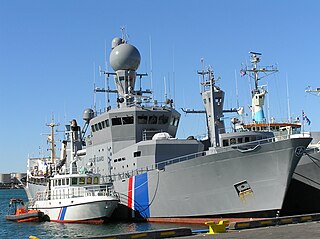
The Ægir-class offshore patrol vessel is a class of two offshore patrol vessels serving in the Icelandic Coast Guard (ICG). They participated in the two latter Cod Wars. The vessels conduct patrols, search and rescue, fishery inspections, general law enforcement and counter-terrorism operations in the Icelandic exclusive economic zone and the waters of the surrounding territories, such as Greenland and Jan Mayen.
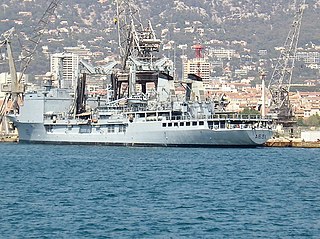
The French tanker Somme is a Durance-class command and replenishment tanker of the French Navy. In addition to its primary duty as a fleet tanker, Somme is configured as a flagship and has served as such in the Indian Ocean. The vessel was constructed at La Seyne, France beginning in 1985 and entered service in 1990. In October 2009, the ship was mistakenly attacked by pirates off the coast of Somalia. The attack was repelled and the pirates captured.
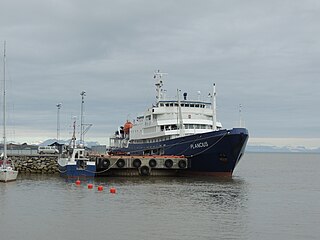
MV Plancius, formerly HNLMS Tydeman (A906), is a renovated oceanographic research vessel of the Royal Netherlands Navy now employed as a polar expedition cruise vessel by owner and operator Oceanwide Expeditions. She was commissioned into the Royal Netherlands Navy on 10 November 1976, and served until 2004, before being renovated for commercial use. The vessel was used for both military and civilian research and had a fracture zone named after it.

HNLMS Van Kinsbergen (F809) was a frigate of the Kortenaer class. The ship was in service with the Royal Netherlands Navy from 1980 to 1995. The frigate was named after Dutch naval hero Jan Hendrik van Kinsbergen.

The Akar class is a series of two replenishment oilers and fleet support ships, designed and built for service in the Turkish Navy. The lead ship of the class, TCG Akar, was constructed in 1982–1983 and entered service in 1987. The second ship, TCG Yarbay Kudret Güngör, was constructed in 1993–1994 and entered service in 1995. Both ships were constructed in Turkey, though Yarbay Kudret Güngör was the first ship built for the Turkish Navy by a private shipyard. Both vessels remain in service.

HNLMS Callenburgh (F808) was a frigate of the Kortenaer class. The ship was in service with the Royal Netherlands Navy from 1979 to 1994. The frigate was named after Dutch naval hero Gerard Callenburgh. The ship's radio call sign was "PADB".

Hassan II (612) is a Floréal-class frigate of the Royal Moroccan Navy. The ship was the first to be constructed for Morocco by Chantiers de l'Atlantique at Saint-Nazaire, France, from 1999 to 2002. The frigate entered service in 2002. Hassan II is the second of two Floréal-class frigates in Moroccan service, the other being Mohammed V.
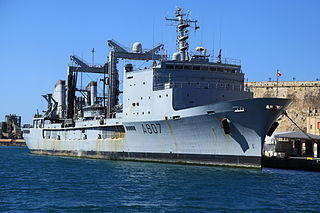
Meuse is a Durance-class replenishment oiler of the French Navy. Constructed by the Brest Arsenal in Brest, France, the vessel was launched on 2 December 1978 and entered service in 1980. The tanker served on several overseas operations, often operating with France's aircraft carriers in a support role. Meuse was taken out of service on 16 December 2015.

Var was a Durance-class command and replenishment tanker of the French Navy. In addition to its primary duty as a fleet tanker, Var was configured as a flagship and served as such in the Indian Ocean. The ship was laid down on 8 May 1979 by Brest Arsenal at their yard in Brest, France. She was launched on 1 June 1981, commissioned on 29 January 1983 and assigned to the Force d'action navale. Var took part in several multi-national operations. The tanker was decommissioned on 1 July 2021.

Marne is a Durance-class command and replenishment tanker of the French Navy. In addition to its primary duty as a fleet tanker, Marne is configured as a flagship and has served as such in the Indian Ocean.




















